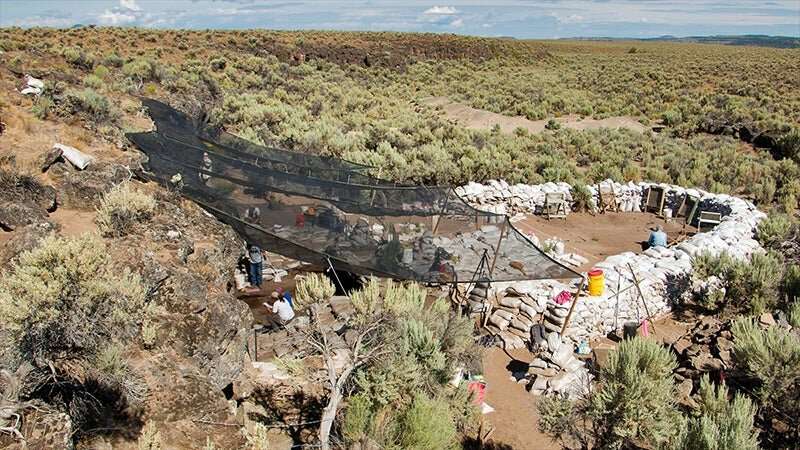This article has been reviewed according to Science X's editorial process and policies. Editors have highlighted the following attributes while ensuring the content's credibility:
fact-checked
trusted source
proofread
Field site shows evidence of humans in Oregon 18,000 years ago

Oregon archaeologists have found evidence suggesting humans occupied the Rimrock Draw rock shelter outside of what is now the Eastern Oregon town of Riley more than 18,000 years ago.
The University of Oregon's Museum of Natural and Cultural History Archaeological Field School, led by archaeologist UO Patrick O'Grady, has been excavating at the Rimrock Draw rock shelter since 2011 under an official partnership agreement with the Bureau of Land Management. Discoveries at the site have included stone tools and extinct mammal tooth fragments from the Pleistocene Epoch. The pieces of tooth enamel are identified as bison and camel.
In 2012, O'Grady's team found camel teeth fragments under a layer of volcanic ash from an eruption of Mount St. Helens that was dated at more than 15,000 years ago. The team also uncovered two finely crafted orange agate scrapers, one in 2012 with preserved bison blood residue and another in 2015, buried deeper in the ash. Natural layering of the rock shelter sediments suggests the scrapers are older than both the volcanic ash and camel teeth.
Radiocarbon dating analysis on the tooth enamel, first in 2018 and then again in 2023, by Thomas W. Stafford Jr. of Stafford Research and John Southon of University of California, Irvine, yielded exciting results: a date of 18,250 years before present.
That date, in association with stone tools, suggests that the Rimrock Draw rock shelter is one of the oldest sites of human occupation in North America.
"This early date aligns well with the oral histories of the tribal nations in the region, many of whom have stories about witnessing geological events like the Missoula floods, a series of events that changed everything for the tribes between 18,000 and 15,000 years ago," said David Lewis, who received his doctorate in anthropology from the UO and is currently a professor of anthropology at Oregon State University. "As well, tribes have oral histories of encountering giant animals, monsters on the land, and Rimrock Draw rock shelter's evidence suggest that we did interact with the megafauna, and they may have become characters in our histories of the time before memory."
Additional testing of other camel and bison tooth fragments is currently underway, and archaeobotanists are studying plant remains from cooking fires as well.
"The identification of 15,000-years-old volcanic ash was a shock, then Tom's 18,000-years-old dates on the enamel, with stone tools and flakes below, were even more startling," O'Grady said.
Currently, another archaeological site on BLM-managed public lands in western Idaho, known as Cooper's Ferry, is thought to be the oldest known site of human habitation in western North America. Evidence there suggests human occupation dating back more than 16,000 years.
"This is a very exciting development for the archaeological community," said Heather Ulrich, BLM Oregon/Washington archaeology lead. "Previous excavations on BLM public lands in Oregon have provided archaeological evidence of human occupation dating back 14,000 years. Thanks to the partnership with Dr. O'Grady and the university, these new dates push our archaeological knowledge of human occupation in North America even farther, perhaps the oldest yet."
This summer, O'Grady plans to complete the final archaeology field school at Rimrock Draw. The team will be working on several units where more ice age animal remains and artifacts are providing supporting evidence for the 2012 discoveries.
Provided by University of Oregon



















